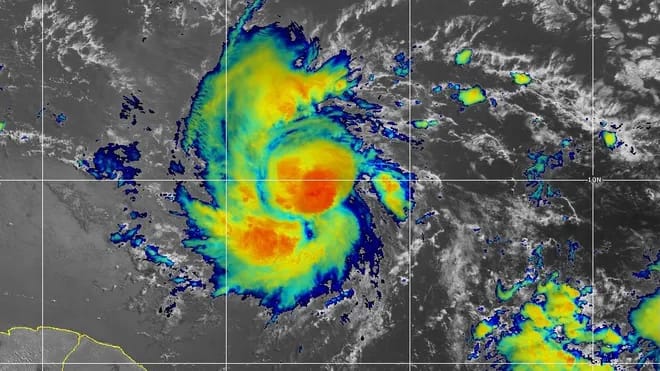
Tropical Storm Beryl has strengthened into a hurricane, the first of the 2024 Atlantic season, with maximum sustained winds of 75 mph with stronger gusts, according to a 5 p.m. EST update from the National Hurricane Center.
The hurricane is located about 720 miles east southeast of Barbados, moving west at 22 mph, and is expected to continue to intensify before reaching the Windwards Islands early Monday. Beryl is now the first rapidly intensifying storm of the year, having accelerated from 35 mph to 75 mph in less than 24 hours. Rapid intensification is defined as a wind increase of 30 knots (35 mph) or more in a 24 hour period.
The center warned earlier on Saturday that the storm was likely to develop into a “dangerous major hurricane” as it approaches the Windward Islands Sunday night or Monday.
Ad Feedback

It brings a risk of heavy rainfall, hurricane-force winds and dangerous storm surge and waves to the central and western Caribbean.
“Beryl is expected to rapidly strengthen and be a major hurricane when it reaches the Windward Islands late Sunday night or Monday, bringing destructive hurricane-force winds and life-threatening storm surge,” warns the center.
The hurricane’s early arrival is unusual: the average date for the first hurricane is August 11. The storm has been intensified by exceptionally warm ocean temperatures, driven by planet-warming fossil fuel pollution.
Beryl could lash parts of the Lesser Antilles – the arching chain of islands that form a broken barrier between the open Atlantic and the Caribbean Sea – by the end of the weekend. A hurricane warning is in effect for Barbados and hurricane watches have been issued for St Lucia, St. Vincent and the Grenadines, and Grenada. Tropical storm watches have been issued for Martinique and Tobago.

The storm is also worth monitoring for those with interests along the US and Mexico Gulf coasts, but it will take a few days to sort out exactly where it will go or how strong it will be. More clarity should come once it is in the Caribbean Sea early next week.
While, in general, early season (e.g., prior to 1 August) Atlantic #hurricane activity has little correlation with overall seasonal activity, early season activity east of the Lesser Antilles is generally associated with very busy seasons, with the notable 2013 exception— Philip Klotzbach (@philklotzbach) June 28, 2024
It’s rare for tropical systems to form and track east of the Lesser Antilles in June. That this formed so early in the season – and in this part of the Atlantic – is a sign of the hyperactive hurricane season to come, according to research from Phil Klotzbach, a hurricane expert and research scientist at Colorado State University.
Normally, ocean temperatures aren’t warm enough in this region in June and July to help tropical systems thrive. That’s hardly the case this year, and one of the reasons behind record-high hurricane season forecasts over the past few months. Ocean temperatures remain close to the off-the-chart highs being set this time last year in the area where the storm is tracking through and are currently at levels more commonly found in August and September.
“Beryl has found an environment with very warm ocean waters for this time of year,” Dr. Mike Brennan, director of the National Oceanic and Atmospheric Administration’s National Hurricane Center, told CNN’s Fredricka Whitfield Saturday.
“These are ocean waters you’d normally see like in August or September, but now we’re seeing them in late June,” Brennan said. “It’s kind of opening up more of the deep tropical Atlantic for formation before we get to what would be the traditional peak of the hurricane season.”
It’s a small slice of a bigger problem. Ocean temperatures across the globe and the Atlantic were record warm for over a year, driven upward by planet-warming fossil fuel pollution and in part by El Niño.
This system is not alone. There are two other areas being monitored by the National Hurricane Center for development, including one in the same area of the Atlantic where this system formed and another in the southwest Gulf of Mexico.
Both have low odds of developing over the next week, but given the unusual early season action and favorable ocean temperatures, they will have to be watched closely.
The NHC is forecasting above-normal activity this year with 17 to 25 named storms – eight to 13 hurricanes, as well as four to seven major hurricanes. “That’s well above average,” Brennan noted.
BERYL IS NOW A HURRICANE AND FORECAST TO INTENSIFY QUICKLY
EXPECTED TO BRING LIFE-THREATENING WINDS AND STORM SURGE TO THE WINDWARD ISLANDS AS A MAJOR HURRICANE
Summary of 500 PM AST…2100 UTC…Information
CLICK HERE TO JOIN OUR WHATS APP GROUP
- Location: 10.1N 49.3W
- About: 720 mi (1160 km) ESE of Barbados
- Maximum Sustained Winds: 75 mph (120 km/h)
- Present Movement: W or 275 degrees at 22 mph (35 km/h)
- Minimum Central Pressure: 992 mb (29.30 inches)
Watches and Warnings
Changes with This Advisory:
- The government of Barbados has issued a Hurricane Warning for the island.
Summary of Watches and Warnings in Effect:
CLICK HERE TO JOIN OUR WHATS APP GROUP
- Hurricane Warning:
- Barbados
- Hurricane Watch:
- St Lucia
- St. Vincent and the Grenadine Islands
- Grenada
- Tropical Storm Watch:
- Martinique
- Dominica
- Tobago
Definitions
- Hurricane Warning: Hurricane conditions are expected within the warning area, typically issued 36 hours before the anticipated first occurrence of tropical-storm-force winds.
- Hurricane Watch: Hurricane conditions are possible within the watch area, typically issued 48 hours before the anticipated first occurrence of tropical-storm-force winds.
- Tropical Storm Watch: Tropical storm conditions are possible within the watch area, generally within 48 hours.
Discussion and Outlook
CLICK HERE TO JOIN OUR WHATS APP GROUP
At 500 PM AST (2100 UTC), the center of Hurricane Beryl was located near latitude 10.1 North, longitude 49.3 West. Beryl is moving westward at 22 mph (35 km/h) and is expected to move across the Windward Islands late Sunday night and Monday.
- Maximum Sustained Winds: Near 75 mph (120 km/h) with higher gusts. Steady to rapid strengthening is forecast, with Beryl expected to become a dangerous major hurricane before reaching the Windward Islands.
- Wind Extent: Hurricane-force winds extend up to 10 miles (20 km) from the center, and tropical-storm-force winds extend up to 60 miles (95 km).
- Minimum Central Pressure: Estimated at 992 mb (29.30 inches).
Hazards Affecting Land
- Wind: Hurricane conditions are expected in the warning area starting Sunday night, with devastating wind damage expected where the eyewall moves through. Wind speeds atop hills and mountains may be up to 30% stronger than the near-surface winds indicated.
- Storm Surge: Life-threatening storm surge will raise water levels by 5 to 7 feet above normal tide levels in areas of onshore flow near where Beryl makes landfall.
- Rainfall:
- Barbados and the Windward Islands: 3 to 6 inches of rain, possibly causing flooding.
- Southeastern Puerto Rico: 1 to 4 inches of rain Monday night into Tuesday.
- Southern Hispaniola: 2 to 6 inches of rain Tuesday into Wednesday.
Additional Information
- Surf: Swells generated by Beryl are expected to reach the Windward and southern Leeward Islands by late Sunday, causing life-threatening surf and rip current conditions. Please consult products from your local weather office.
For storm information specific to your area, please monitor products issued by your national meteorological service.
CLICK HERE TO JOIN OUR WHATS APP GROUP
CLICK HERE TO JOIN OUR WHATS APP GROUP
CLICK HERE TO JOIN OUR WHATS APP GROUP
CLICK HERE TO JOIN OUR WHATS APP GROUP
CLICK HERE TO JOIN OUR WHATS APP GROUP
CLICK HERE TO JOIN OUR WHATS APP GROUP
CLICK HERE TO JOIN OUR WHATS APP GROUP
Advertise with the mоѕt vіѕіtеd nеwѕ ѕіtе іn Antigua!
We offer fully customizable and flexible digital marketing packages.
Contact us at [email protected]














Driven dy the spraying of the skies and geo engineering. These engineering devils will ultimately pay and so will propaganda pushing outlets and meteorologist.
Comments are closed.